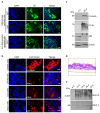Lassa Virus Infection of Primary Human Airway Epithelial Cells
- PMID: 40431605
- PMCID: PMC12116150
- DOI: 10.3390/v17050592
Lassa Virus Infection of Primary Human Airway Epithelial Cells
Abstract
Lassa mammarenavirus (LASV), a member of the family Arenaviridae, is a highly pathogenic virus capable of causing severe systemic infections in humans. The primary host reservoir is the Natal multimammate mouse (Mastomys natalensis), with human infections typically occurring through mucosal exposure to virus-containing aerosols from rodent excretions. To better understand the molecular mechanisms underlying LASV replication in the respiratory tract, we utilized differentiated primary human airway epithelial cells (HAECs) grown under air-liquid interface conditions, closely mimicking the bronchial epithelium in vivo. Our findings demonstrate that HAECs are permissive to LASV infection and support productive virus replication. While LASV entry into polarized HAECs occurred through both apical and basolateral surfaces, progeny virus particles were predominantly released from the apical surface, consistent with an intrinsic apical localization of the envelope glycoprotein GP. This suggests that apical virus shedding from infected bronchial epithelia may facilitate LASV transmission via airway secretions. Notably, limited basolateral release at later stages of infection was associated with LASV-induced rearrangement of the actin cytoskeleton, resulting in compromised epithelial barrier integrity. Finally, we demonstrate that LASV-infected HAECs exhibited a pronounced type III interferon response. A detailed understanding of LASV replication and host epithelial responses in the respiratory tract could facilitate the development of targeted future therapeutics.
Keywords: IFN-λ; Lassa mammarenavirus; primary airway epithelial cells; virus–host interactions.
Conflict of interest statement
The authors declare no conflicts of interest. The funders had no role in the design of this study; in the collection, analyses, or interpretation of data; in the writing of the manuscript, or in the decision to publish the results.
Figures







Similar articles
-
Type I and Type III Interferons Restrict SARS-CoV-2 Infection of Human Airway Epithelial Cultures.J Virol. 2020 Sep 15;94(19):e00985-20. doi: 10.1128/JVI.00985-20. Print 2020 Sep 15. J Virol. 2020. PMID: 32699094 Free PMC article.
-
Lassa virus Z protein hijacks the autophagy machinery for efficient transportation by interrupting CCT2-mediated cytoskeleton network formation.Autophagy. 2024 Nov;20(11):2511-2528. doi: 10.1080/15548627.2024.2379099. Epub 2024 Jul 20. Autophagy. 2024. PMID: 39007910 Free PMC article.
-
Inoculation route-dependent Lassa virus dissemination and shedding dynamics in the natural reservoir - Mastomys natalensis.Emerg Microbes Infect. 2021 Dec;10(1):2313-2325. doi: 10.1080/22221751.2021.2008773. Emerg Microbes Infect. 2021. PMID: 34792436 Free PMC article.
-
A Brighton Collaboration standardized template with key considerations for a benefit/risk assessment for the emergent vesicular stomatitis virus (VSV) viral vector vaccine for Lassa fever.Vaccine. 2025 Jun 11;58:127137. doi: 10.1016/j.vaccine.2025.127137. Epub 2025 May 13. Vaccine. 2025. PMID: 40367816 Review.
-
Lassa virus protein-protein interactions as mediators of Lassa fever pathogenesis.Virol J. 2025 Feb 28;22(1):52. doi: 10.1186/s12985-025-02669-y. Virol J. 2025. PMID: 40022100 Free PMC article. Review.
References
-
- Basinski A.J., Fichet-Calvet E., Sjodin A.R., Varrelman T.J., Remien C.H., Layman N.C., Bird B.H., Wolking D.J., Monagin C., Ghersi B.M., et al. Bridging the gap: Using reservoir ecology and human serosurveys to estimate Lassa virus spillover in West Africa. PLoS Comput. Biol. 2021;17:e1008811. doi: 10.1371/journal.pcbi.1008811. - DOI - PMC - PubMed
-
- McCormick J.B. Epidemiology and control of Lassa fever. Curr. Top Microbiol. Immunol. 1987;134:69–78. - PubMed
Publication types
MeSH terms
Grants and funding
LinkOut - more resources
Full Text Sources

